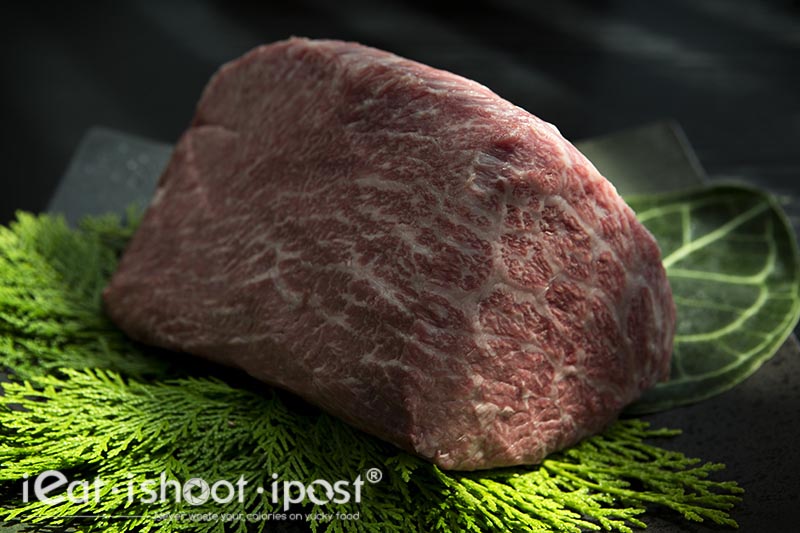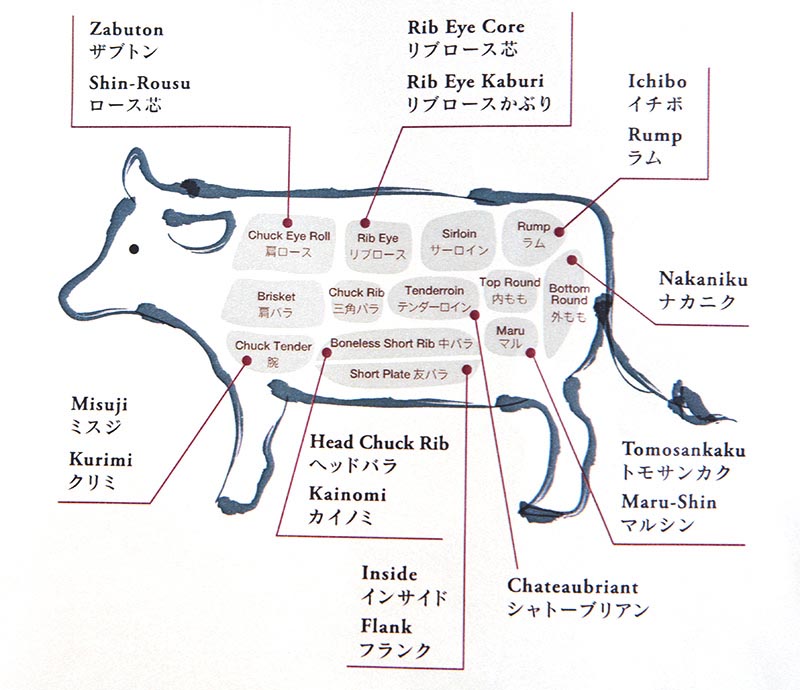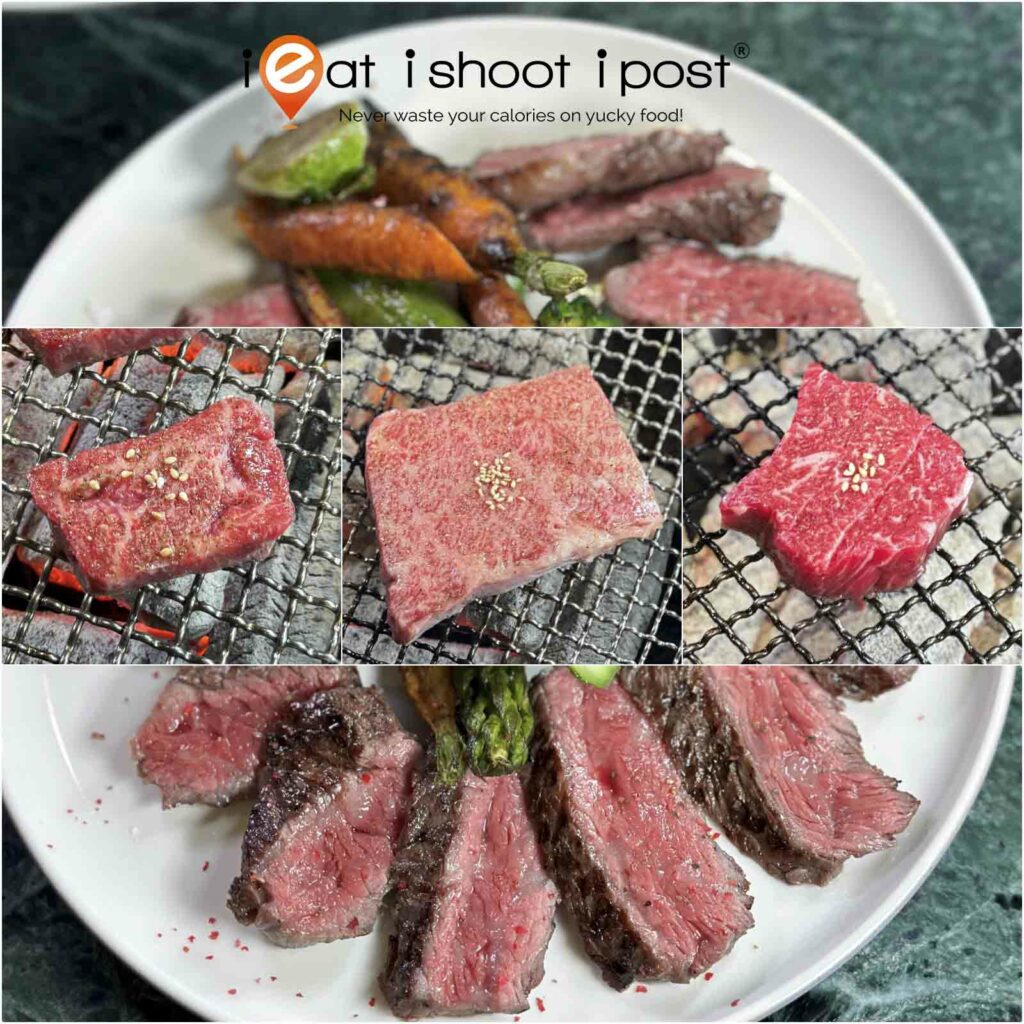
In Part 1, we discussed some of the more familiar cuts of Beef used for steaks. They are the prime cuts which are located on the top (back) of the cow. The meat is tender because the muscles don’t work very hard. However when it comes to Yakiniku, the tender steak cuts are not necessarily the best.
For the Koreans and Argentinians, the short ribs are the most sought after cuts. The meat here is full of beefy flavour, well marbled and have a nice bouncy chew. The Koreans would slice and accordion the meat thin while still attached to the bone and serve it as Galbi in Korean BBQ restaurants. The Argentinians on the other hand eat the short ribs as steaks where they would grill it till it is well done.
Because the beef used for Yakiniku is cut thin and grilled quickly, there is a lot of the other parts of the cattle that is usually used for stew meats and mince that work well for Yakiniku. Granted that when you bite into a 1 cm thick Sirloin that has been quickly seared, you will experience that explosion of juices in your mouth that is quite pleasurable. However, what you are missing is the umami and beefy flavours that come from the meats that have been exercising a lot.
A tough steak is not necessarily a bad steak, so long as it remains juicy and you are able to swallow it when you are ready to swallow it. Try to recall the last time you had a bad steak. You chew the meat and it becomes dry very quickly and when you feel that its time to swallow it, you can’t. Either you chew it a bit more and try to swallow again, or you spit it out. Now, that is a bad steak. However, if you had a slice of well marbled Wagyu brisket, the meat might be a little more chewy but it remains juicy while you are chewing it and the more you chew, the more beefy flavour and sweetness is released. Now that is a good steak! Think of a good chewy steak as chewing gum when you are just starting to chew it and bad tough steak as chewing gum when you are ready to spit it out and you will know what I am getting at.
Today we are going to be focusing on the good chewy meats for Yakiniku!
The first two cuts that we will be discussing come from the meat from the rib cage. The first is the boneless short rib (head bara – belly). This is essentially the continuation of the Chuck Rib (Sankaku Karubi) which we discussed in the last post and consist of the serratus ventralis and latissimus dorsi muscles. The latissimus dorsi are the coverted “wings” that bodybuilders work so hard to develop and is a thin flat muscle covering the ribs.
Just like the Sankaku Karubi, this cut is regarded as a prime Yakiniku cut. The meat is flavourful and it has a nice chew but the marbling can be so intense that you have more fat than meat! It is one of the most beautifully marbled slice of beef you can get at a Yakiniku resturant and always very enticing when you have a few slices on your table! However, you really can’t eat Sankaku Karubi just by itself. You need a more balanced diet with a bit more meat than fat, which is where all the other cuts come in.

Once you remove the meat from the outside of the ribs, there is still some meat in between adjacent ribs. These are the intercostal muscles and there are two sets whose fibres run perpendicular to each other that enable you to inhale and exhale. These are rare cuts as there is only about 1 kg of it in a 500kg carcass and the Yakiniku connoisseurs would specially ask for them. This is the same meat that you enjoy when you are gnawing on your Pai Gu (排骨) in Bak Kut Teh.
Eating the intercostal Karubi is a whole different type of experience. There is a lot of fascia (white sheets between the meat) which makes it really bouncy and almost squeaky when you chew on it. But the flavour is wonderful and the meat continues to release juices while you are chewing it. I guess it is “value for money” meat because each morsel goes a pretty long way!

Now we move the the part of the carcass known as the Round. This is essentially the thigh of the cattle and is a primal made up of many large muscles. Essentially, this is broken down to the muscle group in front of the thigh just above the knee known as the Knuckle (aka Sirloin tip), the muscles on the inside of the thigh called the Top Round, the muscles on the outside of the thigh called the Bottom Round or Silverside/Gooseneck Round and the muscle at the posterior end of the Bottom Round called the Eye of Round (semitendinosus) which is known in the Yakiniku restaurant as the Nakaniku. (Diagram).
Although the Nakaniku muscle is generally considered to be a tougher cut, I had a slice which happened to be quite well marbled and it was very bouncy and chewy and quite enjoyable. It is served as a prime cut at Magosabarou. Many Italian restaurants actually use this cut (non Wagyu) for carpaccio.

Oomomo means “big thigh” in Japanese and refers to the large muscle in the inner portion of the thigh. Top Round) This is usually quite lean even in the Wagyu and is some of the least marbled parts of the Wagyu. This particular piece came from the same cow as the rest of cuts in this series of photos, so you can see how lean this part of the cow is.
The Japanese divide the Top Round into two sections. The Oomomo corresponds to the semimembranosus and adductor muscles while the Komomo is the smaller (and more tender) pectineus and sartorius muscles. The inner thigh muscles are more tender that those of the outer thigh (Bottom Round) and are actually tender enough to enjoy as Yakiniku if they are cut properly. It was beefy and there was lots of umami and sweetness in the meat.
In order to maximize the usage of the beef carcass, the University of Nebraska profiled 21 different muscles in the cattle and used the Warner Bretzler shear force as a measurement of toughness of the meat. The Biceps Femoris which is part of the Bottom Round the Japanese call Sotomomo scored the highest at 9.5 lbs. This is too tough for Yakiniku but its very good for Hamburger mince as it has a wonderful beefy flavour. The Tenderloin (psoas major) scored 3.5 lbs but, surprise surprise, it is not the most tender muslce in the cattle. That honour belongs to the Ribeye cap which consists of the multifidus and spinalis dorsi muscles at 3.4 lbs.

The muscles in the thigh just above the knee cap form a cut the Japanese call Maru. Maru means “circle” in Japanese and it is not hard to understand why when you look at the cross-section of the part of beef which is commonly known as the Knuckle. This cut consist of four muscles, the rectus femoris, lies right in front while the other three muscles are located just in front of the femur (bone) viz vastus intermedius (middle), vastus medialis (inside) and vastus lateralis (outside). The reason I am being so pedentic is because we can reduce wastage of the cattle if we separate the muscle in the Knuckle and serve them individually since the four different muscles vary in toughness. The rectus femoris is the toughest (Warner Bretzler 5.8 lbs) but the portion just behind it ie the vastus intermedius is actually quite tender (Warner Bretzler 3.8 lbs) which is only slightly tougher than the Tenderloin (3.4 lbs).
So although the Knuckle is in the leg and subsequently gets lots of excercise, it really isn’t too tough to eat as Yakiniku and its one of the best parts to order if you want meat that is chewy but juicy with lots of beefy umami and sweetness. It leaves the palate with a nice subtle sweet sensation which we Teochews call “Karm Karm”. Best of all it is much cheaper than the more expensive prime cuts.
The Knuckle is sometimes called Sirloin Tip which you sometimes see on the menus of some restaurants in Singapore. This should not be confused with the more expensive Sirloin cut (Striploin) which comes from the loin portion of the cattle.

The Tri Tip is one of the easiest to cuts to spot. Its triangular shape gives it the name “Tri” Tip and it is basically one muscle called the Tensor Fascia Lata. This muscle is cut from the lower portion of the Sirloin primal and is the part of the cow in between the outer portion of the leg and the abdomen. Imagine a cowboy with a large revolver in his holster. That is about where this muscle lies in your own body.
As you can see from the photo, this is a very nicely marbled cut and is quite tender, very juicy and has a wonderful umami that develops with chewing.

Now we touch on the cuts that are found right at the bottom of the cow which correspond to the chest and abdomen area. These are thin flat muscles which form the covering layer just beneath the skin. Starting from just under the neck is the brisket which is the area where the pectoral muscles lie (The pects or the male neh neh (boobs)) then at the level of the 6th rib is the Plate and then from the 13th rib to the pelvis is the Flank.
In Japanese terminology the Plate is called Tomo Bara where Bara refers to “Belly”. The Plate primal lies underneath the Rib primal and are the abodominal muscles of the cow which consist mainly of the rectus abdominis, external oblique and transversus abdominis muscles.
The meat here is tougher than Karubi but not unpleasantly so. It is chewy and has a wonderful sweet beefy flavour which lingers on the palate.

Finally we get to the Brisket. The Americans love to use this cut for slow smoked BBQ Brisket as well as pastrami. The Brisket is the chest portion of the cattle and basically consist of two portions. The Brisket Flat and the Point. Lovers of Cantonese style stewed brisket will tell you that the best Ngou Lam is made with the Brisket Point which is a wonderfully fatty and marbled meat which is very tough but wonderfully flavourful when slow cooked.

Bottom Row: Brisket, Tomo Sankaku, Maru Core, Plate
The Brisket Flat is the deep pectoral muscle and is ideal for Yakiniku because it is a flat muscle which makes it very easy to cut into attractive little slivers of meat for BBQing. The meat is extremely flavourful and full of umami. It’s a bit more of a chew but very enjoyable.

Conclusion
That concludes the 2 part series on Yakiniku Beef cuts for now. I hope this second part will help you to appreciate the less popular cuts. There has been a lot of focus on these less popular cuts lately and it is part of a global push to reduce wastage and maximise the value of the carcass. Whereas in the past the Chuck might just be used to make mince, now we are discovering that certain muscles can be used as prime meat for steaks as well. So we can eat less but at the same time appreciate more of the cow. Not only is it better for health, it’s good for the environment as well! So do give these lesser known cuts a try the next time you are out for beef!
Special Set Menu for ieatishootipost readers
Set Menu with 5 petite appetizers followed by four cuts of beef, viz Sankaku Karubi, Misuji, Zabuton, Brisket accompanied by steamed vegetables, Hokkaido Scallop, King Prawn, Dessert and Coffee for $80++. (Dependent on availability of the beef cuts)
Please call to reserve and mention the ieatishootipost set. Offer valid till end September 2012.

Useful Links:
1. Major Muscles of the Carcass
2. Canada Beef Anatomical Guide – Useful flash animation
3. Cow Muscle profiling – University of Nebraska
4. US Beef Export Federation – Excellent animated site for beef cutting
5. Youtube Video on cutting the beef hindquarter by Michael Cross
6. Beef Sirloin – Explains the 11 different Sirloin cuts
References:
1. The Art of Beef Cutting, Kari Underly, Wiley 2011
2. Japanese Beef Products Guide Book. MAFF Japan. Downloadable PDF
This article was made possible with the help of Magosaburou Restaurant.










